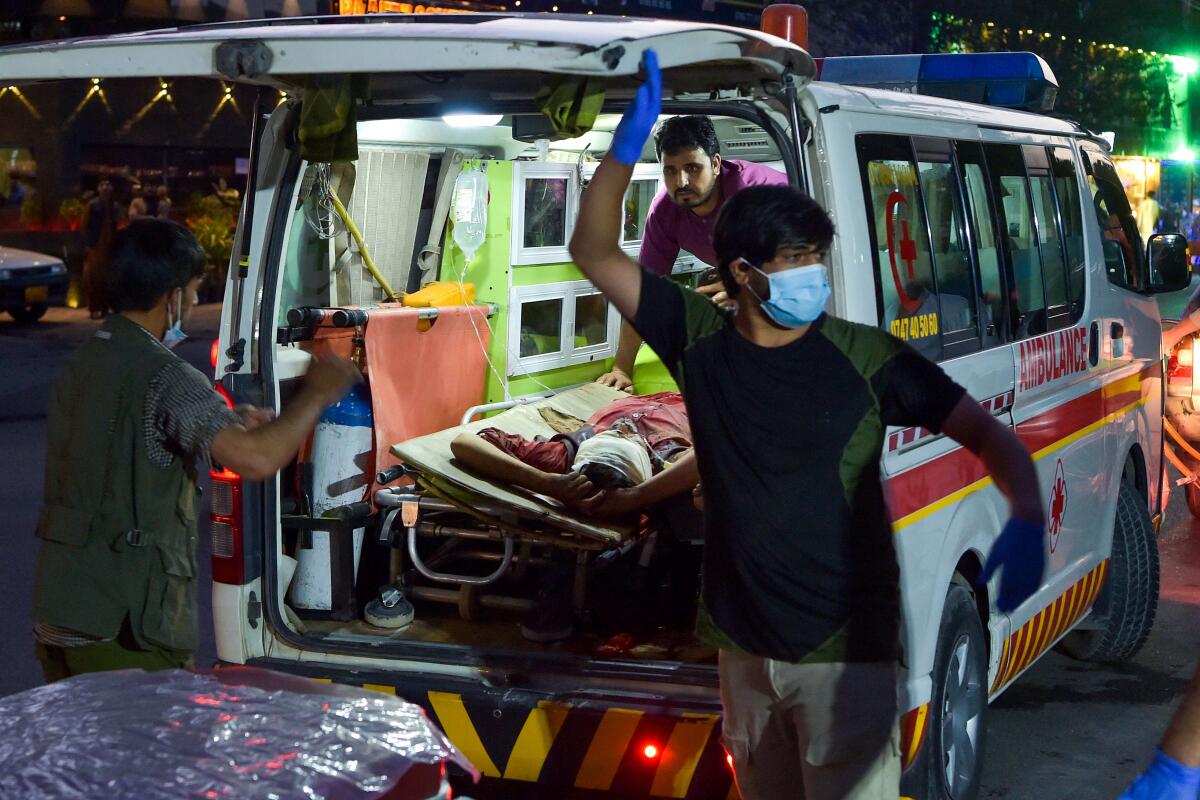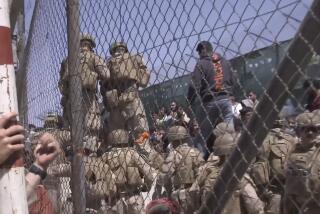Editorial: The latest tragedy in Kabul

- Share via
The killing of at least 13 U.S. service members, mostly Marines, and dozens of civilians in a pair of suicide attacks outside the Kabul airport on Thursday is an outrageous act of terrorism — in this case, at the hands of ISIS-K, an Islamic State affiliate that is active in Afghanistan and Pakistan.
President Biden was right to vow vengeance. “We will not forgive, we will not forget, we will hunt you down and we will make you pay,” he said at the White House.
The attacks are not, however, the work of the Taliban, which has retaken Afghanistan in mere weeks as the Western-backed government and security forces collapsed with scarcely a fight.
Nor are the attacks a sign of failure by the Biden administration, as a host of armchair critics, Washington commentators and Republican cynics have suggested.
We support Biden’s decision to withdraw U.S. forces from Afghanistan by Aug. 31, and his insistence on sticking to that deadline.
In the 11 days before the president addressed the nation Thursday afternoon, the U.S. military had evacuated 100,000 people from Kabul — 7,000 in the previous 12 hours alone. These airlifts have been one of the most complex logistical undertakings in military history, reminiscent of the British evacuation at Dunkirk in 1940 and the Berlin airlift of 1948-49.
No one will soon forget the chaos that accompanied the fall of Kabul, including the heart-wrenching scenes of desperate Afghans holding onto the sides of military aircraft, some later falling from the sky (or dying inside the landing gear). Those moments captured the desperate measures Afghans were willing to take to escape the threat posed by the Taliban to an entire generation’s worth of progress — in education, women’s rights, literacy, health outcomes and personal freedoms.
Critics of the evacuations have made entirely disingenuous, self-serving or simply misleading arguments over the last two weeks. Here is our best attempt to address the major criticisms.
Why do we have to leave Afghanistan at all? President Trump, in direct negotiations with the Taliban that excluded the Afghan government, agreed in February 2020 to a complete withdrawal of U.S. forces by May 1, 2021. When Biden took office, he postponed the deadline to Sept. 11, 2021 (later moved up to Aug. 31). Biden, whose objections — while he was vice president — to further intervention in Afghanistan were overruled by President Obama more than a decade earlier, has been steadfast and consistent in arguing that the Afghanistan war had achieved its main objective — eliminating the terrorist threat from Al Qaeda — and promising that he would not hand off the problem to a fifth president. He has kept that promise.
Why not maintain an uneasy status quo indefinitely, keeping about 2,500 U.S. troops on the ground? Aside from the fact that Trump had considered this option and rejected it, would the American people really want an indefinite troop presence in Afghanistan after spending more than $1 trillion and losing about 2,400 military members? A majority of Americans want out of Afghanistan. One sign of a quagmire is when the missions and aims of the operation can no longer be articulated, much less achieved. The U.S. had long ago reached that point in Afghanistan. Whether the goal was counterinsurgency, nation-building or promotion of women’s rights — all legitimate goals — none would have been achieved by keeping thousands of troops in hostile territory in a “forever war” of the kind both Trump and Biden vowed to end.
But didn’t Biden bungle the planning and execution of the withdrawal? The administration has acknowledged that the Afghan government collapsed far faster than intelligence analysts and most military and diplomatic experts had anticipated. Fair enough. But the truth is that the Afghan government had itself urged against a mass evacuation, fearing that the sight of thousands of Afghans leaving on planes would undermine the already shaky confidence in the government of President Ashraf Ghani and his Western-backed forces. Moreover, as Biden reiterated Thursday, no war ends with a completely smooth, bloodless withdrawal of all troops and allied civilians. “Getting every single person out can’t be guaranteed with anybody,” Biden said.
Will every American who wants to get out be able to? Most likely. The government is “aggressively reaching out” to several hundred Americans known to still be in Afghanistan. Many of them are married to Afghans, or are Afghan Americans, and have reasons for wanting to stay — or, in some cases, have refused to leave unless their Afghan relatives and associates can also leave.
What about all the Afghans who worked with and supported the U.S. during the last 20 years? Our view is that every one of them should be given support in leaving. That effort must not, and will not, end after Aug. 31. The U.S. has already pledged to get out every Afghan who has been granted a special immigrant visa. Because of unforgivable bureaucratic delays, not every deserving Afghan has been granted such a visa. But at this point, the Taliban is not allowing Afghans without paperwork to reach the Kabul airport. So staying at the airport beyond Tuesday would be futile. “Millions of Afghan citizens,” who don’t like the Taliban but also did not work for the United States, “would get on a plane tomorrow if they could,” Biden said Thursday. But the sad reality is that most will not make it out.
Isn’t this a god-awful tragedy? Yes. Also an inevitable one.
More to Read
A cure for the common opinion
Get thought-provoking perspectives with our weekly newsletter.
You may occasionally receive promotional content from the Los Angeles Times.











